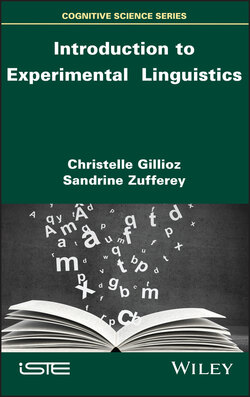Читать книгу Introduction to Experimental Linguistics - Sandrine Zufferey - Страница 19
1.3.2. Explicit and implicit measures of comprehension
ОглавлениеThe second type of experiments used in experimental linguistics include studies conducted on the mechanisms involved in language processing and comprehension. Such processes are numerous and range from the organization of the lexicon, to the comprehension of a text or a discourse. It is therefore the most broadly studied aspect in experimental linguistics. Unlike some aspects of the production component, the language comprehension component is unique, in that it cannot be directly assessed through mere observation. It is outright impossible to directly observe the processes involved in the comprehension of a text, for example. This is why it is necessary to find a way to measure these processes indirectly, based on indicators that can be associated with them.
The first way of collecting these indicators requires the use of explicit tasks in which participants have to reflect upon certain linguistic aspects. For example, this is the case for metalinguistic tasks such as grammaticality or acceptability judgments. This type of task could be used to test the participants’ grammatical knowledge, by showing them syntactically correct or incorrect sentences in compliance with grammatical standards, and asking them to identify errors and justify their choice. While these tasks have the advantage of providing direct access to speakers’ knowledge, they also have the defect of being based on their reflexive skills and their subjective appreciation of their own understanding. These tasks are also particularly complex for certain types of people, especially for children or people with language impairments, for whom it is often very difficult to explain the reasoning behind their decision. Other tasks make it possible to circumvent these problems, by setting up experiments in which the participants have to choose between several illustrations matching a linguistic stimulus. For example, Durrleman et al. (2015) tested the comprehension of relative sentences in people with autism spectrum disorder (ASD), asking them to point to the image corresponding to sentences such as “show me the little boy running after the cat”. Making use of such tasks offers the possibility of studying language comprehension in children and populations suffering from linguistic impairments.
Alternatively, methods for studying comprehension in an implicit manner (without asking the participants directly for a judgment or an explanation of their reasoning) have also been developed. This is the case in action tasks, in which some kinds of behavior adopted on the basis of a linguistic stimulus can be observed. For example, Pouscoulous et al. (2007) tested the understanding of scalar implicatures triggered by words such as quelques (roughly equivalent to some), by asking French-speaking children to arrange tokens in boxes so as to match statements like “quelques cases ont des jetons (some boxes have tokens)”. It is also possible to understand comprehension skills using recall or recognition tasks, in which questions are asked at the end of a reading exercise or after listening to a text or speech fragment. For example, Zufferey et al. (2015a) tested the comprehension of causal relations in children aged 5–8 years, by asking them to answer why questions after every page, when reading a story with them.
